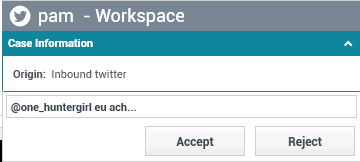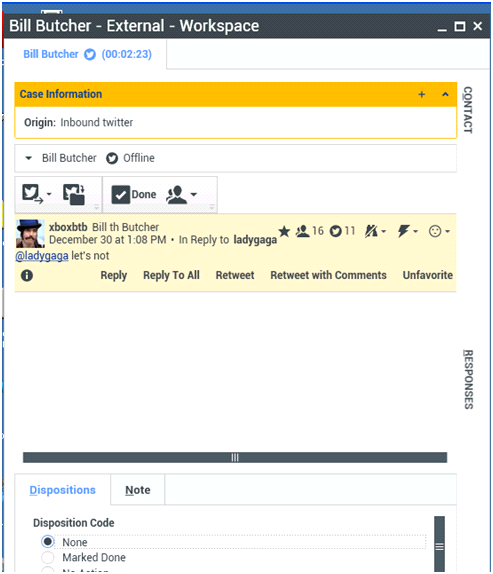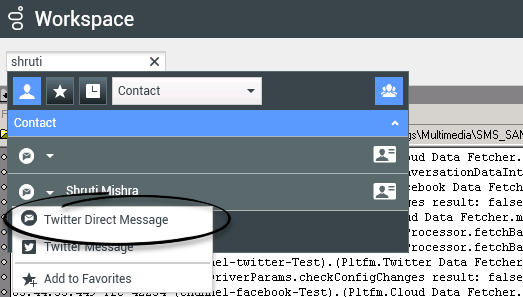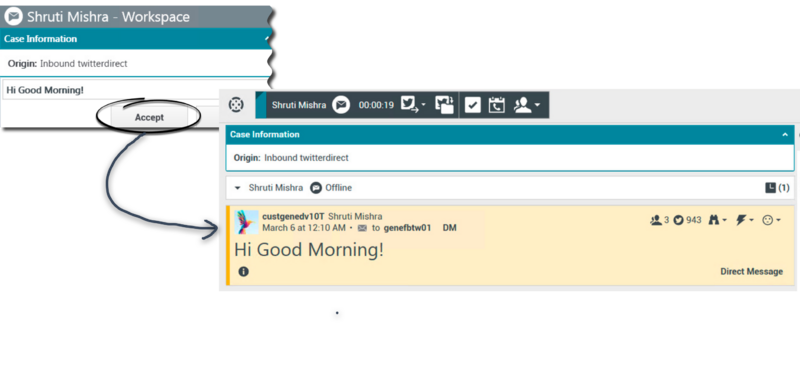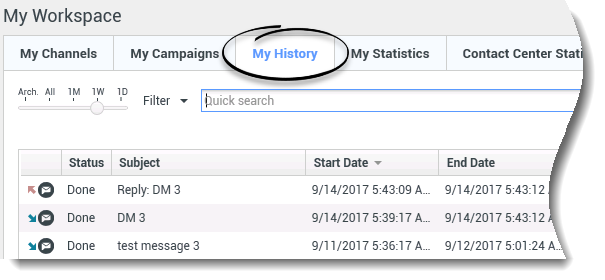Handle A Twitter Interaction
In this lesson, you will learn how to handle inbound Twitter interactions (Tweets), how to check the spelling of your messages before you send, and other Twitter-specific functionality. This lesson contains the following sections:
- Receiving and Handling an Inbound Twitter Interaction
- Twitter-Specific Functionality
- Workspace Functionality
About Twitter
Twitter is an online social networking service and micro-blogging service that enables its users to send and read text-based posts of up to 280 characters, known as Tweets. It has been described as "the SMS of the Internet." These messages are posted to the user's Twitter profile or their blog, sent to their followers, and are searchable on Twitter search. Twitter also has a suite of advertising products to help brands and businesses promote their content within the Twitter experience. Businesses can use Tweets to reach users while they search for their interests on Twitter.
Receiving and Handling an Inbound Twitter Interaction
If you are the selected internal target of an inbound Twitter interaction, you receive a notice on your workstation desktop. You can decide to accept or reject the interaction. If you accept it, the Twitter Interaction window is displayed. The Twitter Interaction window contains information about the interaction and the controls that you need to complete the interaction.
Lesson: Handling an inbound Twitter interaction
Purpose: To handle an inbound Twitter interaction properly.
Prerequisites
- You are logged in to Workspace (see Lesson: Logging in to Workspace).
- Your status is Ready for the Twitter-media channel (see Lesson: Going Ready in the Workspace Main window).
- You are the internal target of the inbound interaction.
Start
- A preview of the inbound interaction is displayed on your workstation desktop in an interactive-notification view (see Figure—Twitter Interaction Notification).
The Interaction Preview contains a summary of information that pertains to the interaction, including contact information and type of interaction. The Interaction Preview might also contain Case Information, which is part of the case data about the interaction.
TipIf you are using a screen reader, your system might be configured to give the focus to the Interaction Preview window. In this scenario, your screen reader will automatically read the window title to you. Navigate to the content area to have your screen reader read the Interaction Preview content. However, if your system is not configured to give the focus to the Interaction Preview window, to have your screen reader read the contents of the Interaction Preview window, you must use screen navigation to give the focus to the Interaction Preview. (Added: 8.5.101.14)If your account is configured for auto-answer, the Interaction Preview is not displayed and the message is answered automatically unless your account is configured to enable you to preview the case information before the interaction is auto-answered. In this case, when you receive an auto-answer interaction, the Interaction Preview is displayed on your desktop. A timer that counts down the number of seconds until you are connected to the contact is displayed in the Accept button (refer to the following figure). You can click Accept before the timer runs out or wait for the timer to run out. The Reject button might also be displayed if your administrator wants you to have the option of rejecting an interaction before it is auto-answered.[Added: 8.5.105.12]

- You can choose to accept or reject the interaction in the Interaction Preview by performing one of the followings steps:
- Click Accept to display the interaction.
- Click Reject to return the interaction to the queue.
- Do nothing. The interaction will time out and be redirected.
- If you accept the interaction, the inbound Twitter Interaction window is displayed, as shown in the Figure—Twitter Interaction Window.
- If there are interactions in progress for the current contact, the number of interactions is displayed beside the connection status of the interaction (see Figure—Dynamic Contact History Matrix). Place your mouse pointer over the icon to display the number and type of interaction(s) in progress (except voice interactions) for the current contact.
You might be configured to be notified if there are recent interactions for the current contact; if so, the number of recent interactions is displayed beside the connection status of the interaction (see Figure—Recent Interactions Matrix). Place your mouse pointer over the icon to display the number and type of recent interactions for the current contact. If you click the icon, the Contact view is opened and the History tab is displayed. Your system administrator defines the contents as interactions during the last-specified number of days.
The original-routed Tweet appears in the left margin under the Twitter interaction toolbar. - To reply to the Tweet, just click Reply. A drop-down menu is displayed.
- Select one of the following:
- Reply--Reply to a Tweet by using the @username prefix, which is automatically inserted
- Reply to All--Reply with a status Tweet that includes mentions. Reply to multiple persons by using @username prefix
- Send Direct Message--When the Twitter message author is a follower, you can send a direct message to the author as a form of reply
- Retweet--Re-post someone else's Tweet without comments
- Retweet with Comments--Re-post someone else's Tweet with comments
- Select a Twitter handle from which you want to send your reply to the Twitter user. If you do not change the Twitter handle, the default handle that is configured in Hub channel configuration page is used to deliver your reply.
ImportantThis feature is available for public Tweets only. Twitter does not allow this function for Twitter direct messages due to security reasons.
- Enter your reply or retweet. You can copy and paste selected text.
- When finished, click Send. Your message is displayed to the contact on Twitter. Your message is also added to the transcript area of the Twitter Interaction window.
For example, if your outbound message is @username Hi, please drop us a private message, then @username is excluded from the character count. If you enter Hi @username, please drop us a private message in the reply text area, @username counts against the character limit.
End
Next Steps
- You may wish to use some of the Twitter-Specific Functionality described below. For example, you may wish to update the Twitter classification or follow/unfollow the Twitter-user. You may also wish to use some of the features in described in Workspace Functionality. When you are finished, click Done to stop the current interaction.The information is saved in the contact history and the Twitter Interaction window is closed.
New Unsolicited Tweets/Messages
Workspace enables you to create and send outbound unsolicited messages to a Twitter user. There are three types: new timeline tweet, tweet with mention, and direct message.
In addition to the actions described below for each type individually, the following actions are common to all three:
New Timeline Tweet
This message goes to all followers of the channel. From the Agent Icon drop-down or Gadget drop-down,
- Select Post Update, then Twitter. A new message window is displayed.
- Select a timeline from the drop-down list.
You can attach an image to the new tweet.
Tweet with Mention
This message goes to a selected contact.
- Click the downward triangle/arrow to the left of the contact name, then select Twitter Message. You can do this from the main Workspace window (see Figure—Send from Main Window below) or the interaction window (Figure—Send from Interaction Window below).
center|Send from Main Window] center|Send from Interaction Window] - In the resulting new message window, select a From account.
- In the new message window, ensure that Mention displays as the title of the drop-down list directly above the message area, as shown in the Figure—Mention in Drop-down below (if the message recipient is a follower of your channel's account, the drop-down is titled Direct): frame|center|Mention in Drop-down The new message begins with an @<username> mention.
Twitter Direct Message
You can send and receive a direct message using Twitter Direct. The contact must be a follower of yours and your direct messages are between you and the selected contact only. No one else can see them.
Direct message interactions from Twitter are displayed on the interaction window via the Twitter Direct button:
Sending a Direct Message
You can send a direct message to a contact (this is distinct from the direct message that you can send as a reply). From the main Workspace window or the interaction window, click the downward triangle/arrow to the left of the contact name, then select Twitter Direct Message:
Accepting an Incoming Direct Message
From the main Workspace window, click Accept on the Twitter Direct Message popup, and the interaction window opens:
Viewing your Direct Message History
You can view your message history, by clicking My Workspace > My History from the main Workspace window. From this window you can do a Quick search, Filter your results, or use the slider to search within a specific timeline.
Attach an Image
You can attach an image to a new unsolicited Tweet, a reply, a Reply to All, a new Direct Message, or a Retweet with Comments. (You cannot attach an image to a retweet).
To attach an image, click the Add Picture icon ![]() , then use the resulting dialog box to navigate to the desired file.
, then use the resulting dialog box to navigate to the desired file.
This icon appears below the text box in replies and Retweets with Comments; it appears below the text box in unsolicited Tweets.
The following image formats are supported:
- JPEG
- JPG
- PNG
- GIF
Twitter-Specific Functionality
The Twitter Interaction window provides some Twitter-specific functionality.
You can:
- Display Twitter-user profile information. Click Show Info to display the user profile information. You can also click the user name to open the Twitter page that contains user profile information (see the Figure—Buttons and Icons for Twitter-Specific Functionality).
- Display the number of Twitter-user Tweets. The number after the Statuses Count icon indicates the number of user Tweets (see the Buttons and Icons for Twitter-Specific Functionality figure).
- Display the Actionability and Sentiment of the Twitter interaction. When a Twitter interaction arrives, you can view Actionability and Sentiment icons (see the Buttons and Icons for Twitter-Specific Functionality figure), which could have one of the following values or be undeclared:
- Actionability—Can be actionable, not actionable, or undeclared.
- Sentiment—Can be Positive, Negative, Neutral, or undeclared.
Actionable Tweets are colored yellow and non-actionable Tweets are colored gray. Actionability and Sentiment are based on the classification and screening results obtained from Genesys Knowledge Management.
- Update the Actionability and Sentiment of the Twitter interaction. While processing the interaction, you have the option to change the value of the corresponding Actionability and Sentiment key by clicking the related icon and then choosing the correct value.
- Display the Followers Count. The number after the Follower Count icon (see the Buttons and Icons for Twitter-Specific Functionality figure) indicates the number of Twitter users following this account.
- Display the designation that the user is a Follower. The Follower icon (see the Buttons and Icons for Twitter-Specific Functionality figure) indicates that the user is a Twitter follower.
- Display an attached image by clicking the preview of the image.
- Designate a tweet as Favorite by clicking the Favorite button. The tweet then appears with a star icon. You can also unfavorite a tweet.
- Follow/Unfollow a Twitter user. You can become or stop being a follower of an author of the Twitter message. Click the Followed button to unfollow this account (see the Buttons and Icons for Twitter-Specific Functionality figure). A menu appears where you can select Unfollow. The button changes to Not Followed (see the Buttons and Icons for Twitter-Specific Functionality figure). Or, in case you change your mind, click the Not Followed button. The menu re-appears where you can select Follow.
- Automatic insertion of mentions. An @ sign and mention are automatically inserted into replies. The @ sign is used to call out usernames in Tweets, like this: Hello @JoeBelow! When a user name is preceded by the @ sign, it becomes a link to a Twitter-user profile.
- Reply to all participants in the current Tweet thread. Click Reply. A drop-down menu is displayed. Select Reply to All.
- Send a direct message to an author of a Tweet message. When the Twitter message author is a follower, you can send a direct message to the author as a form of reply.
- Retweet. Click Reply, select Retweet from the menu, and enter your Retweet. Right-click, select Spell Checking from the menu, correct any spelling errors, and then click Send.
- Retweet with comments. You can make a new Tweet, including the text of current message, and add additional comments. A Retweet indicator (RT) is automatically inserted at the start of the message text. Click Reply, select Retweet with Comments, enter the comment text (you can copy and paste selected text), and click Send Retweet with Comments.
- Open a clickable shortened URL. Twitter messages are limited to 280 characters. All URLs, including short forms like goo.gl will be counted as a 23-character string. Workspace supports shortened URLs.
- Open a Twitter user profile page by using clickable mentions. The @ sign is used to call out user names in Tweets, like this: Hello @JoeBelow! Click a user name preceded by the @ sign to link to a Twitter user profile.
- Perform a search in Twitter by using a clickable #hashtag. Twitter uses the # symbol, called a hashtag, to mark keywords or topics in a Tweet. Hashtags help you to find Tweets of interest. You can use the hashtag symbol before relevant keywords in Tweets to categorize those Tweets to display more prominently in a Twitter Search. Clicking on a hashtagged word in any message shows you all other Tweets in that category. Hashtags can occur anywhere in the Tweet.
- Display In-Reply to Tweet. If the delivered Tweet interaction is a reply to another Tweet, Workspace enables you to view the original Tweet by clicking on the user name located after "In Reply to". A new browser window opens to display the parent Tweet in Twitter.
- Delete an outbound Tweet from your history by clicking Delete.
Notes
- Currently, Promoted Tweets for Twitter platform are not supported as they are not directly referenced to any @mention or mapped to any tracked keyword.
Workspace Functionality
While you are interacting with your Twitter contact, you can use the general Workspace functionality in the Twitter Interaction window.
- Use the Note to attach a note to the interaction history. See Managing Contact History.
- View Case Information for the current interaction.
- View and manage contact history. See Managing Contact History
- View and manage contact information. See Lesson: Finding and viewing an interaction in the contact database.
- Your account might be configured to let you assign an interaction with an unknown contact to a known contact in the contact database by using the Manual Contact Assignment feature.
- You can move an outbound interaction that you are working on into a workbin.
- Use the Standard Response Library for pre-written text for replies and comments. Click the vertical Responses button in the Using The Standard Response Library lesson.
- Cross over into another media channel. If, as an agent, you learn other contact information (not Twitter-specific), such as a contact's phone number or email address, you can manually enter this information on the Information tab. The corresponding choice for other media channels is then displayed when you click the Party Action menu that is next to the name of the contact. You can then reply by using a voice call, an email, an SMS message, or any other supported media channel for a Twitter contact. Workspace displays a drop-down list of available channels to access a contact.
- If you want to transfer the interaction to another internal target or consult with another internal target about the interaction, you can perform the following functions:
- Instant-transfer the interaction to another internal target. See Lesson: Starting an instant SMS transfer, which is similar to the Twitter procedure.
- Start a consultation with another party:
- Start an Instant Messaging consultation. See Lesson: Initiating an Instant Messaging session.
- Start a Voice consultation. See Starting a Voice Consultation.
- When you are finished interacting with your contact, click Done to stop the current interaction.
- The information is saved in the contact history and the Twitter Interaction window is closed.
- Set a disposition code. See Assigning Disposition Codes.

